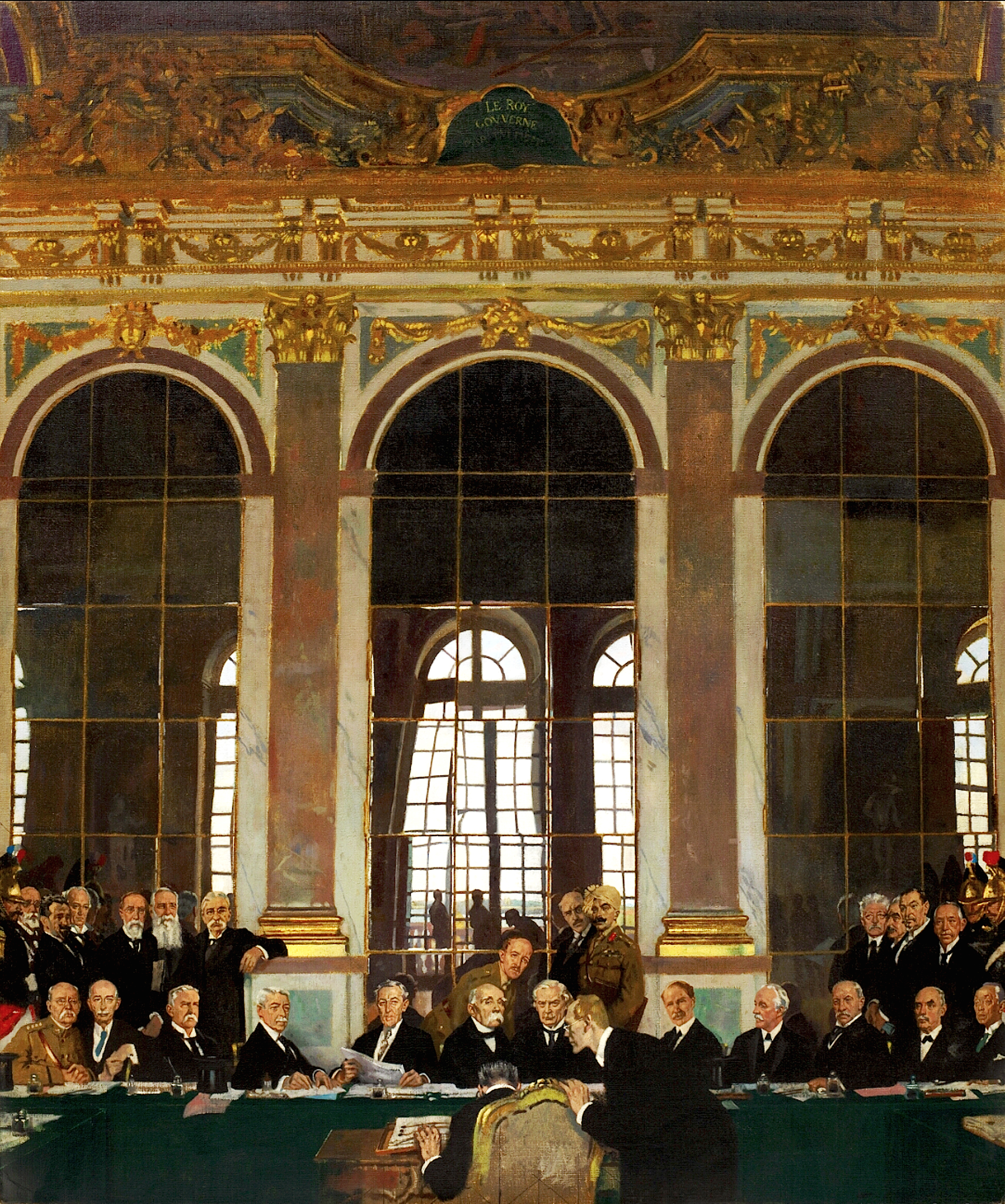How exactly does freedom work? A selection of important peace agreements from history and their inevitable breaches on SCHIRN MAGAZINE.
Has there ever been a time when absolute peace has reigned? Possibly, in times about which we know nothing. Leaving this kind of conjecture aside, probably not. And coming to this conclusion does not require extensive research. It would appear that war, be it on a large or small scale, is in our blood. But not in all of us; that goes without saying. Yet, as we all know, it only takes a couple of people in positions of authority to make millions of people’s lives a misery.
Since we have never been able to examine that time of “absolute peace” and will probably never be in a position to do so, let us at least look at some significant peace agreements. Despite the countless wars that have raged throughout the history of mankind there have nevertheless been a number of peace accords. We will be casting our eye explicitly over those brief moments in which peace was brokered and an agreement reached. Capitulations (for example Germany’s unconditional capitulation in 1945), cease-fires (in 1973 between the USA and North Vietnam; on the Vietnam War cf. the article “A dark chapter”) and treaties to prevent war (including the Charter of the United Nations and the Covenant of the League of Nations which formed part of the Treaty of Versailles) will not form part of this discussion.
Can we distinguish between important and less important peace accords? Ultimately, what counts is that peace has been negotiated. Nevertheless, a number of these agreements have had far-reaching consequences and others have not, at the end of the day, delivered what they promised.
EGYPTIAN-HITTITE PEACE TREATY
ca 1259 BCE
The oldest-known peace accord was concluded between Pharaoh Ramesses II and King Ḫattušiliš III around 1259 BCE. In the 14th and 13th centuries BCE Egypt was experiencing an economic and cultural boom and its influence stretched all the way to the Near East. At the same time the Hittites, whose empire corresponded largely to modern-day Turkey, were also expanding their territories with the aim of weakening Egypt’s preeminence in the region. The borders of the two empires met at present-day Lebanon and border skirmishes were inevitable. The situation escalated with the Battle of Kadesh, one of the best-documented battles in Antiquity. However, neither of the two sides emerged victorious. Fifteen years passed before the Hittites found themselves threatened by a third party, the Assyrians, which induced King Ḫattušiliš III to offer Ramesses II a peace accord and an alliance agreement. Written testimony to this agreement has survived to the present day.

Hieroglyphic text of the peace treaty between Ramesses II and Hattusili III, Gudrun Meyer at the German language Wikipedia, via Wikimedia Commons
“PERPETUAL PEACE” BETWEEN THE BYZANTINE EMPIRE AND THE SASSANIDS
532 CE
The “Perpetual Peace” was concluded between Byzantine Emperor Justinian and Great King Khosrau I in 532 CE. Over a period of centuries, the Roman Byzantine Empire and the Neo-Persian Sassanian Empire were the two preeminent powers in the Mediterranean region. The peace agreement concluded in 506 CE had been preceded by a cease-fire intended to last seven years (and lasting, surprisingly, 20 years). However, towards the end of the rule of Byzantine Emperor Justin I the conflict reignited and was fought out in two large-scale battles, in each of which a different army triumphed. At the start of the subsequent rule of the Roman Emperor Justinian the latter held out an olive branch to the Persians, but it was not until the Persian King Khosrau I ascended the throne that a formal agreement was reached. Justinian had hoped to achieve a lasting settlement between the two parties, but this was not to be. He had placed so much trust in the peace accord that in subsequent years he neglected the defense of the Eastern Roman province. Khosrau I took advantage of this in 540, when he attacked Roman Syria. A bloody war followed and peace became a thing of the past.

Anushirawan [Chosrau I.] the Just (justice statue) by Gholamreza Rahimzadeh Arjang, By Photo:مانفی (self) [CC BY-SA 3.0, GFDL or Public domain, via Wikimedia Commons
PEACE OF NUREMBERG
1532 CE
In the Peace of Nuremberg dating from July 23, 1532, Emperor Charles V and the Protestants agreed, for the first time, to a mutual guarantee of peace under the rule of law. This represented an end to the persecution of the Protestants, thus making it possible for the Reformation to spread unhindered. The thinking behind this accord was purely strategic. Emperor Charles V needed free rein in the Holy Roman Empire in order to repel the Turks, who had occupied Hungary. However, the Protestant princes, who had banded together in the Schmalkaldic League, wanted to secure their political and economic interests and extend their power base by means of state-church rule, something which effectively meant that the power of ecclesiastic governance would also be invested in them as territorial sovereigns. Seven years after the Peace of Nuremberg, the Treaty of Frankfurt was signed, again safeguarding the relationship between Protestants and Catholics within the Empire.

Titian, Equestrian Portrait of Charles V, [Public domain], via Wikimedia Commons
PEACE OF PRAGUE
1866 CE
The 1866 Peace of Prague (there had been a previous one in 1635) ended the Austro-Prussian war. The latter war was fought between Prussia and its allies on the one side and Austria, representing the German Confederation, on the other. Prussia was victorious, the German Confederation was dissolved and a replacement was sought, but one excluding Austria. The North German Confederation was subsequently formed under the leadership of Prussia, a precursor to the German Empire, which would be established in 1871. The southern German states of Württemberg, Baden and Bavaria made peace with Prussia, entering in on something known as “defensive and offensive” alliances, initially secretly.

Ordines Sacri Romani Imp. Ab Ottonoe III Instituti, Colored engraving by Antonie Wierix, 1606, [Public domain], via Wikimedia Commons
TREATY OF VERSAILLES
1919 CE
The Treaty of Versailles was one of five treaties drawn up subsequent to the 1919 Paris Peace Conference which formally ended World War I. These treaties were drawn up by the Allied Powers and had to be signed by the representatives of the defeated nations. They also included the statutes of the newly established League of Nations. In the Treaty of Versailles sole responsibility for the outbreak of World War I was attributed to Germany, the country was obliged to make territorial concessions, disarm and pay reparations. Even some contemporaries such as British economist John Maynard Keynes considered the treaty too hard on Germany and some observers recognized even then the dangers of a destabilized and isolated German economy, which would inevitably lead to social instability. Many historians see in the Treaty of Versailles key contributing factors to the rise of Nazism.

William Orpen, The Signing of Peace in the Hall of Mirrors, Versailles, 28th June 1919, [Public domain], via Wikimedia Commons
EGYPT-ISRAEL PEACE TREATY
1979 CE
This peace treaty ended a state of war that had existed between Israel and Egypt since 1948. The treaty was signed in Washington D.C. on March 26, 1979 by Israel’s Prime Minister Menachem Begin and Egyptian President Anwar Sadat. In the treaty it was agreed that Israel would surrender the Sinai Peninsula (including oil springs there) to Egypt, that Israeli settlements there would be dismantled and the Jewish population “removed”, if necessary by force. The Strait of Tiran and the Gulf of Aqaba were recognized as international waterways and the free passage of Israeli ships through the Suez Canal allowed. The treaty made Egypt the first Arab nation to recognize the State of Israel. A taboo had been broken and it resulted in Egypt being excluded from the Arab League and led to the murder of Sadat by Islamist extremists in 1989.

Menachem Begin, Jimmy Carter and Anwar Sadat at Camp David, By Fitz-Patrick, Bill, photographer [Public domain], via Wikimedia Commons
DAYTON AGREEMENT
1995 CE
In 1995, an end was put to three and a half years of war in Bosnia and Herzegovina in Dayton, Ohio. The relevant peace agreement was drawn up on November 21 and signed in Paris by Serbian President Slobodan Milošević, Croatian President Franjo Tuđman and President of Bosnia and Herzegovina Alija Izetbegović. The peace agreement was brokered by the United States with the participation of the European Union; the peace talks were chaired by then US President Bill Clinton. The war in Bosnia and Herzegovina was part of a series of wars connected with the breakup of Yugoslavia. The memory of this war is still with us today, particularly because of the massacre of Srebrenica in which up to 8,000 people, mainly men and boys, were killed despite the presence of UN Blue Berets. Even today, why the UN soldiers failed in their mission has never been explained in full.

December 14, 1995: Serbian President Slobodan Milosevic, Bosnian President Alija Izetbegovic, and Croatia President Franjo Tudjman, (Credit: William J. Clinton Presidential Library), By The Central Intelligence Agency [Public domain], via Wikimedia Commons

ABOUT TIME. With Marie-Theres Deutsch
Marie-Theres Deutsch was born in 1955 in Trier at the central western tip of Germany, into a family of five women and a father who was an architect....

These boots are made for walking
Shoes are silent storytellers, revealing secrets about their wearer's personality, status and desires. No wonder, then, that artists like Carol Rama...

Seeing nature anew – through a cube
In his early work, HANS HAACKE addressed the relationship between art and nature as well as the social interest in the reciprocal relationship between...

The film to the exhibition: Hans Haacke. Retrospective
A legend of institutional critique, an advocate of democracy, and an artist’s artist: The film accompanying the major retrospective at the SCHIRN...

A new look at the artist – “L’altra metà dell’avanguardia 1910–1940”
With “L’altra metà dell’avanguardia 1910–1940”, in 1980 Lea Vergine curated an exhibition at the Palazzo Reale in Milan that was one of the first...

Non-human living sculptures by Hans Haacke and Pierre Huyghe
In his early work, HANS HAACKE already integrated animals and plants as co-actors into his art. In that way he not only laid the foundations for a...

CURATOR TALK. CAROL RAMA
SCHIRN curator Martina Weinhart talks to Christina Mundici, director of the Carol Rama Archive in Turin, editor of the first Catalogue Raisonné and...

Freedom costs peanuts
HANS HAACKE responded immediately in 1990 to the fall of the Berlin Wall and turned a watchtower into art.

The film to the exhibition: CAROL RAMA. A REBEL OF MODERNITY
Radical, inventive, modern: The film accompanying the major retrospective at the SCHIRN provides insights into CAROL RAMA's work.

Now at the SCHIRN: Hans Haacke. Retrospective
A legend of institutional critique, an advocate of democracy, and an artist’s artist: the SCHIRN presents the groundbreaking work of the compelling...

Carol Rama’s Studio: A nucleus of creativity
CAROL RAMA determinedly forged her own path through the art world. Her spectacularly staged studio in Turin was opened to the public only a few years...

PANEL: POLITICAL ACTIVISM BY SELMA SELMAN
Hosted by Arnisa Zeqo, Amila Ramović and Zippora Elders speak with the artist Selma Selman about her artistic career, the exhibition SELMA SELMAN....